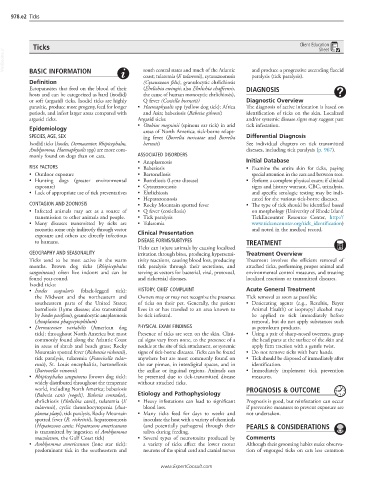Page 1956 - Cote clinical veterinary advisor dogs and cats 4th
P. 1956
978.e2 Ticks
Ticks Client Education
Sheet
VetBooks.ir
BASIC INFORMATION
south central states and much of the Atlantic
coast; tularemia (F. tularensis), cytauxzoonosis and produce a progressive ascending flaccid
paralysis (tick paralysis).
Definition (Cytauxzoon felis), granulocytic ehrlichiosis
Ectoparasites that feed on the blood of their (Ehrlichia ewingii; also Ehrlichia chaffeensis, DIAGNOSIS
hosts and can be categorized as hard (ixodid) the cause of human monocytic ehrlichiosis),
or soft (argasid) ticks. Ixodid ticks are highly Q fever (Coxiella burnetii) Diagnostic Overview
parasitic, produce more progeny, feed for longer • Haemaphysalis spp (yellow dog tick): Africa The diagnosis of active infestation is based on
periods, and infest larger areas compared with and Asia; babesiosis (Babesia gibsoni) identification of ticks on the skin. Localized
argasid ticks. Argasid ticks: and/or systemic disease signs may suggest past
• Otobius megninii (spinous ear tick) in arid tick infestation.
Epidemiology areas of North America; tick-borne relaps-
SPECIES, AGE, SEX ing fever (Borrelia turicatae and Borrelia Differential Diagnosis
Ixodid ticks (Ixodes, Dermacentor, Rhipicephalus, hermsii) See individual chapters on tick transmitted
Amblyomma, Haemaphysalis spp) are more com- diseases, including tick paralysis (p. 967).
monly found on dogs than on cats. ASSOCIATED DISORDERS
• Anaplasmosis Initial Database
RISK FACTORS • Babesiosis • Examine the entire skin for ticks, paying
• Outdoor exposure • Bartonellosis special attention in the ears and between toes.
• Hunting dogs (greater environmental • Borreliosis (Lyme disease) • Perform a complete physical exam; if clinical
exposure) • Cytauxzoonosis signs and history warrant, CBC, urinalysis,
• Lack of appropriate use of tick preventatives • Ehrlichiosis and specific serologic testing may be indi-
• Hepatozoonosis cated for the various tick-borne diseases.
CONTAGION AND ZOONOSIS • Rocky Mountain spotted fever • The type of tick should be identified based
• Infected animals may act as a source of • Q fever (coxiellosis) on morphology (University of Rhode Island
transmission to other animals and people. • Tick paralysis TickEncounter Resource Center, http://
• Many diseases transmitted by ticks are • Tularemia www.tickencounter.org/tick_identification)
zoonotic; some only indirectly through vector Clinical Presentation and noted in the medical record.
exposure and others are directly infectious
to humans. DISEASE FORMS/SUBTYPES TREATMENT
Ticks can injure animals by causing localized
GEOGRAPHY AND SEASONALITY irritation through bites, producing hypersensi- Treatment Overview
Ticks tend to be most active in the warm tivity reactions, causing blood loss, producing Treatment involves the efficient removal of
months. Brown dog ticks (Rhipicephalus tick paralysis through their secretions, and attached ticks, performing proper animal and
sanguineous) often live indoors and can be serving as vectors for bacterial, viral, protozoal, environmental control measures, and treating
found year-round. and rickettsial diseases. localized reactions or transmitted diseases.
Ixodid ticks:
• Ixodes scapularis (black-legged tick): HISTORY, CHIEF COMPLAINT Acute General Treatment
the Midwest and the northeastern and Owners may or may not recognize the presence Tick removal as soon as possible:
southeastern parts of the United States; of ticks on their pet. Generally, the patient • Desiccating agents (e.g., Resultix, Bayer
borreliosis (Lyme disease; also transmitted lives in or has traveled to an area known to Animal Health) or isopropyl alcohol may
by Ixodes pacificus), granulocytic anaplasmosis be tick infested. be applied to tick immediately before
(Anaplasma phagocytophilum) removal, but do not apply substances such
• Dermacentor variabilis (American dog PHYSICAL EXAM FINDINGS as petroleum products.
tick): throughout North America but most Presence of ticks are seen on the skin. Clini- • Using a pair of sharp-nosed tweezers, grasp
commonly found along the Atlantic Coast cal signs vary from none, to the presence of a the head parts at the surface of the skin and
in areas of shrub and beach grass; Rocky nodule at the site of tick attachment, or systemic apply firm traction with a gentle twist.
Mountain spotted fever (Rickettsia rickettsii), signs of tick-borne diseases. Ticks can be found • Do not remove ticks with bare hands.
tick paralysis, tularemia (Francisella tular- anywhere but are most commonly found on • Tick should be disposed of immediately after
ensis), St. Louis encephalitis, bartonellosis the ear pinnae, in interdigital spaces, and in identification.
(Bartonella vinsonii) the axillae or inguinal regions. Animals can • Immediately implement tick prevention
• Rhipicephalus sanguineus (brown dog tick): be presented due to tick-transmitted disease measures.
widely distributed throughout the temperate without attached ticks.
world, including North America; babesiosis PROGNOSIS & OUTCOME
(Babesia canis [vogeli], Babesia conradae), Etiology and Pathophysiology
ehrlichiosis (Ehrlichia canis), tularemia (F. • Heavy infestations can lead to significant Prognosis is good, but reinfestation can occur
tularensis), cyclic thrombocytopenia (Ana- blood loss. if preventive measures to prevent exposure are
plasma platys), tick paralysis, Rocky Mountain • Many ticks feed for days to weeks and not undertaken.
spotted fever (R. rickettsii), hepatozoonosis inoculate the host with a variety of chemicals
(Hepatozoon canis; Hepatozoon americanum (and potentially pathogens) through their PEARLS & CONSIDERATIONS
is transmitted by ingestion of Amblyomma saliva during feeding.
maculatum, the Gulf Coast tick) • Several types of neurotoxins produced by Comments
• Amblyomma americanum (lone star tick): a variety of ticks affect the lower motor Although their grooming habits make observa-
predominant tick in the southeastern and neurons of the spinal cord and cranial nerves tion of engorged ticks on cats less common
www.ExpertConsult.com

